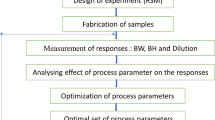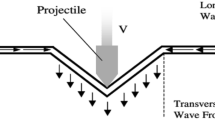Abstract
Sheet metal parts are widely used in the assembly of aircraft. The most common method of assembling sheet metal parts is through riveting. Failure of a rivet can have severe consequences in terms of loss of human lives and money. There are many parameters associated with a riveting process that directly affect the quality of rivets including squeeze force, rivet length, rivet diameter, and hole diameter tolerance. Incorrect selection or variations in these parameters could induce excessive residual stresses that result in stress concentration sites and initiate cracks, and also result in improper rivet head deformation leading to loose rivets. This paper presents a study of the effect of the aforementioned riveting parameters on the quality of a formed rivet using finite element simulation. The study was part of a larger project carried out for the local aircraft industry and hence, uses the inch system. The research is conducted on a 1/8″ (0.125″) diameter rivet and a 0.064″ thick aluminum sheet. The results indicate that under normal variations in the riveting process parameters, when using the recommended countersunk depth of 0.042″ for rivet hole, most rivets that are formed will not meet the quality requirements. This is primarily due to the existence of a gap between the formed rivet and the hole. Decreasing the countersunk depth to 0.032″ allows for a higher range of hole and rivet diameter tolerances, as well as an increase in the range of squeeze force that can be applied without violating the quality requirements.
Similar content being viewed by others
References
Szolwinski MP, Farris TN (2000) Linking riveting process parameters to the fatigue performance of riveted aircraft structures. J Aircr 37(1):130–137
Military Standardization Handbook (1994) Metallic materials and elements for aerospace vehicles structures (MIL-HDBK-5G) Defense Automated Printing Services, Philadelphia
Reithmaier L (1991) Standard aircraft handbook, Tab Aero (5th edn.). Blue Ridge Summit, PA
Smith CR (1957) The fatigue strength of riveted joints. Aircr Eng 32(375):142–144
Frost NE, Marsh KJ, Pook LP (1974) Metal fatigue. Oxford University Press, London
Seliger V (1943) Effect of rivet pitch upon the fatigue strength of single-row riveted joints of 0.025 inch 24S-T alclad. NACA TN 900
Holt M (1950) Results of shear fatigue tests of joints with 3/16″ diameter 24S-T31 rivets in 0.064″ thick alclad sheet. NACA TN 2012
Heywood RB (1962) Designing against fatigue. Chapman and Hall Ltd., London
Endurance of riveted lap joints (aluminum alloy sheet and rivets) (1979) ESDU Data Sheets No. 79031. Engineering Sciences Data Unit, London
Ekvall JCE (1986) Fatigue of riveted metallic joints. ASTM STP 927, pp 172–189
Fung CP, Smart J (1996) An experimental and numerical analysis of riveted single lap joints. Proc Inst Mech Eng 208:79–90
Iyer K, Rubin CA, Hahn GT (1999) Three-dimensional analysis of single rivet row lap joints - Part I: Elastic response. Recent Adv Solids Struct 398:23–39
Iyer K, Rubin CA, Hahn GT (1999) Three-dimensional analysis of single rivet row lap joints - Part II: Elastic-Plastic response. Recent Adv Solids Struct 398:41–57
Silva LFM (2000) Multiple site damage in riveted lap-joints: experimental simulation and finite element prediction. Int J Fatigue 22:319–338
Muller RPG (1995) An experimental and analytical investigation on the fatigue behavior of fuselage riveted lap joints. PhD Thesis, Delft University of Technology, the Netherlands
Li G, Shi G (2004) Effect of the riveting process on the residual stress in fuselage lap joints. Can Aeronaut Space J 50(2):91–105
Li G, Shi G, Bellinger NC (2005) Studies of residual stress in single-row countersunk riveted lap joints. 46th AIAA/ASME/ASCE/AHS/ASC Structures, Structural Dynamics and Materials Conference. Austin, Texas, pp 18–21
Author information
Authors and Affiliations
Corresponding author
Additional information
An erratum to this article can be found at http://dx.doi.org/10.1007/s00170-008-1593-3
Rights and permissions
About this article
Cite this article
Cheraghi, S.H. Effect of variations in the riveting process on the quality of riveted joints. Int J Adv Manuf Technol 39, 1144–1155 (2008). https://doi.org/10.1007/s00170-007-1291-6
Received:
Accepted:
Published:
Issue Date:
DOI: https://doi.org/10.1007/s00170-007-1291-6




